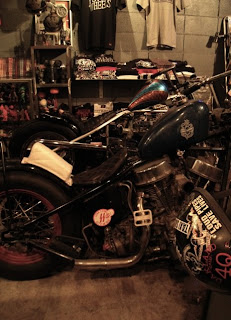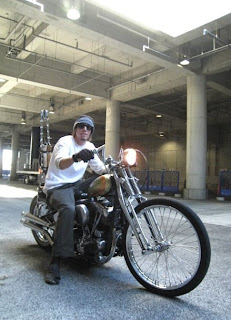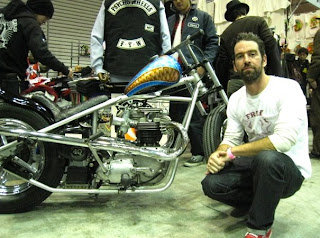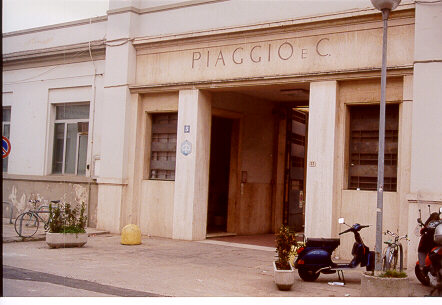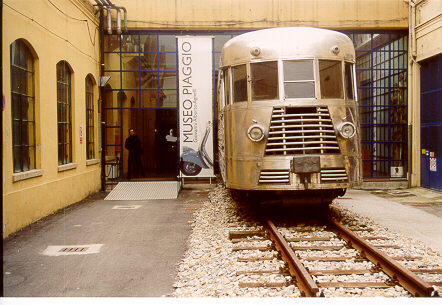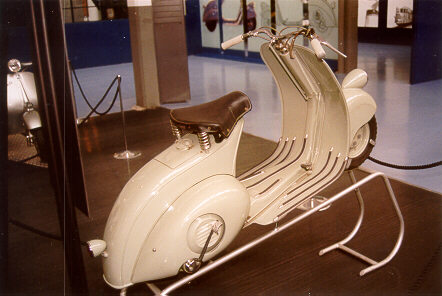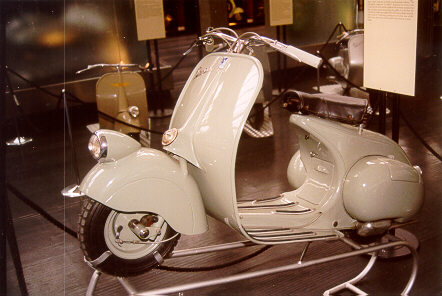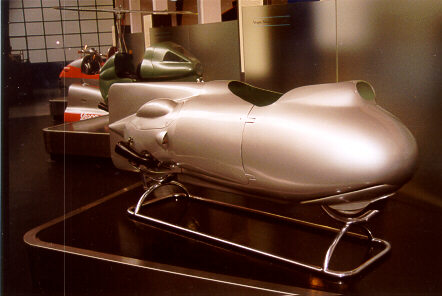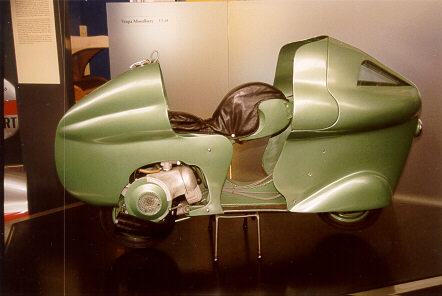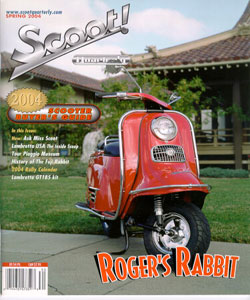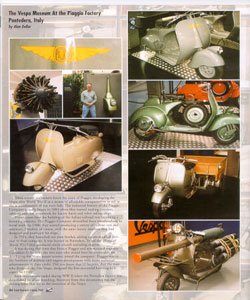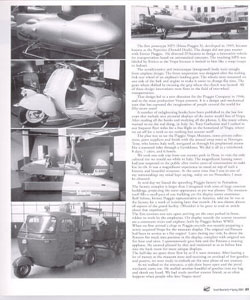 Actually, what I did was spend a little time searching the Internet for examples of ceremonial spears. That was the "flavor" I was looking to duplicate. The result was a walking stick that totally blew Max away. Far from being disappointed with my failure to build it to his specifications, Max was delighted. It was far and away better than his expectations. That is EXACTLY the reaction I was looking for.
Actually, what I did was spend a little time searching the Internet for examples of ceremonial spears. That was the "flavor" I was looking to duplicate. The result was a walking stick that totally blew Max away. Far from being disappointed with my failure to build it to his specifications, Max was delighted. It was far and away better than his expectations. That is EXACTLY the reaction I was looking for. Actually, what I did was spend a little time searching the Internet for examples of ceremonial spears. That was the "flavor" I was looking to duplicate. The result was a walking stick that totally blew Max away. Far from being disappointed with my failure to build it to his specifications, Max was delighted. It was far and away better than his expectations. That is EXACTLY the reaction I was looking for.
Actually, what I did was spend a little time searching the Internet for examples of ceremonial spears. That was the "flavor" I was looking to duplicate. The result was a walking stick that totally blew Max away. Far from being disappointed with my failure to build it to his specifications, Max was delighted. It was far and away better than his expectations. That is EXACTLY the reaction I was looking for.- Starting at the back of the assembly, a 5 stud clutch hub is a worthwhile upgrade for performance use. Whether you upgrade your existing hub, or buy a new one may come down to a money issue. If you can change the studs yourself it may be cheaper to do that, but if you have to pay someone to change the studs, it may be just as cost effective to buy a new 5 stud unit.
- Replace the "clutch hub fiber disc" with the "Nylatron" unit. In normal use, this fiber disc works as another clutch plate. That means that it is susceptible to making the clutch drag if there is insufficient release between it and the back of the clutch basket. Since this plate is behind the clutch hub bearing, it is also inordinately susceptible to grease from that bearing, further enhancing the probability it will drag. Whether the Nylatron disc was designed this way or not, what I like to do is treat it like a bearing rather than a clutch plate. I grease up the Nylatron disc on both sides to make it unlikely to give any drag. An added bonus to the Nylatron is that it is "full floating", so you don't have to worry about riveting it in like the stock disc.
- Next, in place of the stock clutch hub bearing retainer, install a "Ram Jett Retainer". I believe this little item is named after its originator, but is now being sold generically by all the major parts wholesalers. This little item is a rigid plastic/nylon disc that goes on after the basket is installed on the hub. It is installed with snap rings in place of the stock "spring clips". Depending on the indexing of the disc, it will give more or less end play to the clutch basket. Remember what I said about the Nylatron disc being used to make the assembly like a bearing rather than another clutch plate? The Ram Jett Retainer forms the other end of this "bearing assembly" and controls the end play. Controlling the end play eliminates the basket from "walking out" and causing clutch drag
- Clutch plates. Besides making sure that the plates are in good shape (not oil soaked or glazed) the other consideration is what use the clutch will be put to. For even hard street use, I would still recommend cheap replacement fiber discs. I remember (from back in the old days) one particularly successful street class racer used a particular brand of cheap aftermarket fibers with great success. Due to having a high horsepower motor along with a street tire, he slipped his clutch while launching the bike, managing a near perfect blend of RPM and traction. Sort of like a slipper clutch, only with the rider's clutch hand providing the magic. After every pass, he would swap the clutch plates out, allowing the most recently run ones to cool. I wish I could remember what brand plates he said he ran, because he did say not all of them worked equally well.
- Working our way out, an aluminum pressure plate will almost always work better than the original stamped steel one. They don't flex. They are also surprisingly affordable.
- The -41 clutch springs will give more pressure than the later hand clutch versions. Keep in mind that this will make your lever pull a little heavier though (that is why they changed them when they eliminated the mousetrap; also known as a hand clutch booster)
- The clutch spring retainer is the steel disc at the outer end of the clutch that the 5 nuts (now that you upgraded from a 3 stud hub) tighten. It will have 5 "nubs" that the special nuts index on. You're going to want to grind those nubs off. Discard the special nuts and use nylock nuts in their place. Now you will be able to get a fine adjustment on the pressure plate rather than in 1/2 turn increments as the special nuts provide.
- Now if your bike is going to be used mostly on the street, and you have no clutch drag, you are all done. If, however, this clutch is going to see some major drag racing use, you might want to keep reading. Most clutch problems on the drag strip are related to dragging, not slipping. Even a clutch with perfect street manners will tend to drag when your bike is staged and at 4000 RPM or more. Remember, all the clutch needs to do is "pull" your bike an inch or two and you have red lighted. Besides, it is pretty much impossible to cut a good light when distracted by a dragging clutch. The solution (if you have addressed all of the items here and in the first post) is to add more release travel. As I mentioned in part 1, you can remove the hand grip to allow the clutch lever to move farther. A layer of electrical tape will make the bar a little less slippery without a grip. One last trick. You can also add a little more travel to the clutch release by shortening the release arm (the lever that comes off the top of the kicker cover). You should be able to take about an inch out of the center of this arm without adding too much misalignment to the cable. Remember, this will also make for a heavier lever pull.




There you have it! All the tricks and tips that I know for the 4 speed clutch... well, at least all of them I remember. Will this solve all of your clutch problems on the street? I think so. On the strip? To a point. Even with a more modern clutch, I found that a 6000+ RPM launch required a line lock on the front brake to avoid being pulled through the lights. But for a 60 year old clutch design, I think you'd have to agree it was a good one.
It seems that a commenter by the name of Steve has some real issues with Christians opposing "gay marriage". In fact the long and short of his various comments come down to this. It is hypocritical for Christians to spend more time opposing "gay marriage" than they do in opposing the liberalization of divorce laws since both of these things weaken the institution of marriage. The exchanges in the comments section have been numerous and heated.
I have a lot of thoughts and opinions on these subjects, but to narrow this post down to a manageable size I want to comment on only one aspect. To the cry of "Hypocrite! Hypocrite!", I answer; Guilty! Guilty!
You see, that is what real Christianity is all about. Being a hypocrite. Despite God's work of giving us a new spirit, redeeming us by his blood, and making us free from the penalty for our sins, we are still stuck with this flesh. And as long as we are stuck with this flesh we will continue to sin.
Paul touches on this in Romans 7:18-24 where he says: "For I know that in me (that is, in my flesh,) dwelleth no good thing: for to will is present with me; but how to perform that which is good I find not. For the good that I would I do not: but the evil which I would not, that I do. Now if I do that I would not, it is no more I that do it, but sin that dwelleth in me. I find then a law, that, when I would do good, evil is present with me. For I delight in the law of God after the inward man: But I see another law in my members, warring against the law of my mind, and bringing me into captivity to the law of sin which is in my members. O wretched man that I am! who shall deliver me from the body of this death?"
So, if your complaint is that Christians are hypocrites, then you are right indeed. But being a hypocrite does not relieve a Christian of his duty to proclaim God's word; all of it, even when it is not convenient. This is a Christian's duty, even when he will be called a hypocrite and unloving for doing it. Yes, a Christian is to proclaim God's word in as loving a manner as he can, but what could be more unloving than not proclaiming it at all.
I, for one, am longing for the day when I no longer have this sinful flesh to deal with.
As I alluded to in an earlier post, I plan to build a Knuckle using a set of dual Linkert heads that I already have. The first thing I did after committing to building this bike was to order a set of new STD replica Knuckle crankcases. I know, I know.... I've already ruined it for some of you! Sorry, but there is just no way I can justify the cost of a set of original cases, not to mention the inherent weakness in an aluminum casting that has seen at least 60 years of abuse. I hope that you purists will find it in your heart to forgive me.
Another major piece has been donated by my good friend Watso. After reading my blog he called me to offer a replica Panhead frame. Needless to say, that is a major step forward in the project, and Watso's generosity makes the whole thing much more financially feasible for me.
Sorting through my stash of used parts I came up with these to be added to list of parts I plan to use:
- a set of XA (pre '74) rods which I will have shot peened and rebuild
- breather and circuit breaker drive gears
- a pre 1940 oil pump (customarily used for drag racing because of their lower volume)
- 3 out of 4 rocker arms and all 4 shafts
- a front rocker box
- a front lifter block
- 16" spokes and rim for the rear
- a few Linkert carb bodies to experiment with
- the complete vintage drag racing 2 speed transmission from Don Jone's 1950 drag bike, "The Gorilla". I will need to freshen it up, but it will be the real "centerpiece" of the bike.
- a clutch hub and basket
- a new reproduction Panhead rear cylinder
- damaged inner and outer primary covers to be modified into a primary chain guard
I have new Rowe exhaust valves and guides. On the intake side I have a set of Screamin' Eagle 2.080" valves (selected because of their shallow tulip and being the correct size for the existing "choke" in the heads). The 5/16" stem diameter of these valves necessitate fabrication of custom valve guides, for which I have already obtained the blanks from Rowe. I have also ordered a set of flywheels from Truett & Osborn .
That still leaves me searching eBay for a few items:
- a rear exhaust rocker arm
- a rear rocker box
- a rear lifter block
- a cam cover
- a magneto (though for the price they seem to go for it may make more sense to buy a new one from Joe Hunt rather than buying used and then sending it out for a rebuild)
At this point in time, my plans are to buy a reproduction springer, which will help to give the bike that real vintage look. I will also likely buy a pair of reproduction star hubs, since it seems like you always have to take five used ones apart to find one good one. Rear fender will likely be a cut down reproduction. Cam? Leineweber without a doubt. The only question is whether it will be the #3 or the #5 grind. I plan to get a little further with the heads before making that decision.
One thing I am still up in the air on, is what fuel tank I should use. I toyed with using a Hummer tank, but seeing what they bring on eBay may have ruled that out. Thoughts?
By the way, this bike has found a nickname before it has even had its first two parts permanently bolted together. Vinnie.... short for vintage drag bike.
But not for the last week and a half!
The laptop is in for major repairs, and not due back until the 8th. The silver lining is that I had purchased an extended warranty on it (something I would not normally do). I guess having the warranty put off the day when I switch over to a Mac. Microsoft has become something of a dirty word around our house, with the untold hours lost due to programs that don't work correctly. And then there are the viruses.
I have to admit to a little nagging suspicion in the back of my mind wondering whether it is the people at Mac who spend their evenings producing viruses that attack PCs. Nah....couldn't be....
Anyway, that is why I haven't posted for a while. Hopefully that will change soon.
During those two weeks of life support, things looked hopeless. I readily admit that a week into that life support my wife and I had given up hope and accepted the fact that the patient would be lost and should be allowed to die with dignity.
As of last Sunday, it looked as though the funeral would be today after all. But mid week, all of that changed. The patient is still very weak, and there is no assurance that she will survive to live to a ripe old age, but there is a great hope that is evident in her that had been missing before.
Of course the "patient" that I have been describing is our own beloved Valley View Baptist Church. Two weeks ago we were to vote on closing, being without a pastor and down to 21 members (or less), However, there were enough members at that meeting who were not quite willing to close just yet. The vote was put off for two weeks until after the yearly meeting of the Minnesota LaCrosse Association of the North American Baptist Conference, in the hopes that member churches could offer some guidance.
Despite the prayers and offers of support from the member churches in the association, Jane and I came to the conclusion (based primarily on being better informed) that perhaps it was for the best that Valley View Baptist close its doors.
But all that has changed now. Dennis Ingolfsland, one of our members, has volunteered to take over as our pastor on a part time basis. Dennis, beside being a professor at a nearby Christian college, has often preached for us when our former pastor was out of town. I am confident that the entire membership at Valley View is delighted at this turn of events. Best of all, I believe that the membership is going into this with the realization that we will all need to be involved in regaining the health of Valley View Baptist. I don't think any of us have any illusions of growing into a large church; in fact I am not sure we really even want to. But we do wish to restore the church to the point where it can survive as a God honoring body of Christ were the gospel is preached!
Please continue to pray for us.
But, tonight I received a call from Wyman, one of our deacons, with some very encouraging news. I won't go into detail yet, but if you have been praying for us, then I'd like to thank you from the bottom of my heart, because I do believe your prayers have been answered! And as is so often the case our most gracious Father has chosen to answer them in a most unexpected way.
More to follow....
In the hills of Galilee,
I would follow as He walked,
On the shores of Galilee,
I would listen as He talked;
Always healing human ill,
Always teaching love devine:
Pleading, "Whosoever will,
Come, and comfort shall be thine."
Wonderous man of Galilee,
Face so meek and eye so mild;
Teach me how to follow Thee,
I would be thy loving child;
Teach me how to watch and pray,
Give me hope and faith and love;
In thy footsteps all the way,
Lead me till I land above.
Wonderous man of Galilee,
Thou hast balm for all my woe;
All my ills I bring to Thee,
Thou dost ease them, this I know.
Take and fold my troubled heart,
To Thy bosom warm with love;
Help me ne'er from Thee to part,
Lead me to that home above.
I will be adding more details shortly, but here is a teaser. They will be running all pre 1972 vehicles; Top Fuel Front Engine Dragsters, Nitro Burning Funny Cars, Blown Gassers and Altereds, Super Stockers, A F/Xers, Jet Cars, Wheelstanders, Hot Rods, and MOTORCYCLES.
Of course, the part about MOTORCYCLES is of particular interest to me. If you have been following my blog, you already know that I have a lot of interest in vintage drag bikes, and have been toying with the idea of building one. This event put me over the tipping point.
The only question now is what combination of parts I will use. I still have the heads and cylinders from my last drag bike, which was a 120 cubic inch Knucklehead. But, I also have a very nice set of vintage dual Linkert Knuckle heads that would look killer on a 50's style Knuck drag racer. The third option is to use a set of single carb Knuck heads (which I also have) with the Scot blower that was once used on a real live '50s drag bike. You can read more about it from an earlier post here.
So, what do you think? I am kind of leaning toward the dual Linkert motor because of it's classic look and simplicity to build. Still, the blower has some great history to it....
The complaints generally go something like this: "The bike still tries to creep forward even with the clutch lever pulled all the way in." The clutch is grabby." "It's hard to get into first gear." "It's hard to find neutral."
A few items are all it generally takes to make the clutch work "as good as new." A few more trick can make it better than new.
Here are some common problems and solutions.
- Oil soaked and gummy fiber plates - solution: replace the discs. There have been a lot of "stop gap" measures to avoid replacing the fibers over the years such as baking to draw the oil out, spraying with brake cleaner and such. None of the work particularly well. Buy even the cheapest replacement fibers you can get, and you will be much more satisfied.
- Glazed fiber plates - solution: same as above, replace the discs. A stop gap measure is to "rough up" the surface, usually by rubbing them on some concrete
- Primary chain or belt misaligned - solution: align. If your clutch basket is inboard in relation to the engine sprocket, when you pull in the clutch, the basket will naturally move out to align with the engine sprocket. This takes up the free space between the plates that pulling in the clutch was supposed to give, resulting in a dragging clutch.
- Primary chain or belt too tight - solution: adjust. Very similar to number 3 above. Obviously adjusting a chain is pretty easy. Some belt drives are non adjustable due to rigid primary housings. Consult the manufacturer as to why his product doesn't fit correctly. I am sure he will tell you that it is the first time he has heard of this problem. Then switch to a chain.
- Clutch hub studs grooved - solution: replace the studs or the clutch hub assembly. This manifests itself in a dragging clutch due to the fiber discs (which have the small holes that the studs go through) being hindered from moving due to the grooves. If you choose to repair this by replacing studs, you can convert it to a 5 stud at the same time. The only advantage to a 5 stud is that allows a finer adjustment for the springs.
- Clutch basket dogs grooved - solution: replace dogs or basket.This is similar to #5 above, except that it is the steel plates that have worn grooves into the dog s on the basket. This is far less common than grooved studs.
- Clutch pressure plate warped -solution: replace. If the pressure plate is not flat, it will be very difficult to adjust the clutch so that the plate releases evenly. The best solution to this is to upgrade to an aftermarket aluminum pressure plate, often referred to as a precision pressure plate.
- Clutch springs out of adjustment - solution: adjust. This can show up in a couple of ways. Springs that are not adjusted with enough tension can slip. Springs that are adjusted too tightly may coilbind before there has been enough movement of the pressure plate to allow full disengagement. The most prevalent problem, though, is not adjusting the springs for even pressure. This can cause the cause the clutch to be grabby or to drag. Your service manual tells you to adjust the three nuts on the clutch hub studs so that there is 1 inch between the stock pressure plate and the inside of the spring retainer. That is a good starting point, but for best results you need to pull in the clutch while watching the pressure plate and adjust those nuts so that the pressure plate comes out evenly. In other words, if one side of the plate starts to move before the other, adjust the nut on that side in a half turn or two until the pressure plate comes out evenly. Turn the pressure plate to different points in its rotation and double check this release. This is a major cause of a grabby clutch, and is easy to remedy!
- Clutch pushrod and adjusting screw not having "squared off" ends - solution: machine them or replace them. This fits hand in hand with #8 above. Somewhere along the line, someone came up with the bright idea of making a clutch adjusting screw (the screw that goes into the center of the pressure plate) with a ball bearing in the end. Obviously they thought this would be a plus if you did not adjust the clutch with enough free play. The problem is that it aggravates the problem of the pressure plate not releasing evenly as described above. Picture the difference between balancing a 5 gallon pail on top of another 5 gallon pail (with lid). Now picture balancing the 5 gallon pail on a basketball. Any small difference in spring pressure from one side of the pressure plate to the other will be magnified by "balancing it on an adjusting screw with a ball on the end of it. Usually the pushrod itself will have an end that is already "squared off."
- Insufficient travel of pressure plate for full disengagement. solution: restore full travel. This can be as simple as adjusting the clutch free play. Obviously if your clutch lever moves an excess amount before it starts to move the pressure plate, it may hit its full travel before the pressure plate has moved far enough to fully disengage the clutch. It is best to unhook the clutch cable, and then adjust the screw in the center of the pressure plate. In most cases this can be accomplished by turning the screw in until it lightly bottoms, and then back off a quarter turn. Then go back, hook the cable up, and adjust the free play at the lever. You must leave some free play or the throw out bearing will burn up. This is all it should take if all else is in good stock working order. There are a couple of other possible issues though. One is if you have a set of the really thick aftermarket grips that are on the market today. Your clutch lever will bottom out on this grip before it traveled as far as it would with the stock grip. (when I drag raced, I wouldn't run any grip at all on the clutch side just to add a little more travel) Another potential problem is in some of the clutch cables I have seen. In an effort to make clutch cables more "flexible" some of them have been "woven" with wires that are not stiff enough. I have seen cables that actually stretch somewhat as the lever is pulled, and then relax again when the lever is released. Sort of like using a big spring to release your clutch.
Well, that pretty much covers the common causes and solutions for the 4 speed clutch problems, at least those that have come to mind. I may remember more later. In a future post I intend to cover some tricks and tips for high performance use. All in all, great performance can be realized without resorting to replacement of this durable clutch with one of a different design.
(note: I tried both the "numbered list" function, as well as the "bulleted list" function and they both change to the goofy flower when I publish the post. Maybe I should add "Blogger" to my book of shame.)
One question that has come to my attention recently pertains to who the worship service should be "aimed" towards. It may be that the "seeker sensitive" service that was all the rage for quite some time now, may be on its way out in "modern" churches. Some would argue that the seeker sensitive service missed the mark, because it was aimed at the wrong target. A church service should be for the Christian, not for the person who is trying to decide whether or not they should become one, they say.
Frankly, I agree with that assessment, to a point. Anyone who has followed this blog for any time probably realizes that I am a conservative Baptist (and I hope that term has no connotations that I am unaware of). As such I don't have much time for the whole seeker sensitive thing. From what I have seen of it, the seeker sensitive church, to a large extent, has come down to luring in people (who are interested in spiritual things) by promising to be relevant and entertaining, and to enhance their life, but never really getting to the subject of sin and the answer to sin.
Now a second way of looking at a church service has more merit, in that a church is an assembly, and a Church (note the capital C) is an assembly of believers (and being a Baptist, I would add baptized believers). John 4:23 says "But the hour cometh, and now is, when the true worshippers shall worship the Father in spirit and in truth: for the Father seeketh such to worship him." Hence a church service, or worship service would rightly focus on those who are already Christians.
So far, this second type of service is a pretty good description of ValleyView Baptist over the past year and a half that my wife and I have been members. Nearly all of the sermons from our pastor (who has recently moved on to another church) were basically aimed toward edifying the body of Christ. While the subject of sin and the gospel were certainly not avoided, neither were they stressed because after all, those receiving the sermons were professed Christians. This is NOT meant in any way to reflect adversely on him; the fact is we miss and love him dearly.
In this vein of "doing church" specifically for the Christian, I recently heard a pastor say that he no longer invites people to church. He said he does his evangelism only after getting to know someone. Some of you may agree with him. Others may be shocked. Me? Well ....
I have to agree that there is no point to inviting someone to your church if the gospel is not going to be preached. And just as important, if sin is never going to be mentioned, there is no point in preaching the gospel, since the man with a terminal illness who doesn't know it, will have little use for a life saving medicine. Wasn't that a major problem with the seeker sensitive service? So, by all means, if you are not going to preach about sin and the gospel, don't invite unbelievers to your church. But I do believe that may come with its own issues.
I have heard (from more than one source) that young people attending Christian colleges, in many cases, cannot even articulate the basic tenants of the faith. Do you think there is a chance that many of these never really were born again? After all, if they grew up in the typical seeker sensitive church, they may have never been told of their desperate need of a saviour. But does this not also apply to the child who grew up in a church where "church" was done just for Christians?
Let me tell you a little story that helps explain how I come down on this issue. Nearly 10 years ago, my wife and I attended a church service due directly to an invitation in the form of literature brought to our door. No, not Jehovah's Witness or Mormon; some Baptist's go door to door also.
This was a fairly small church. Small enough that new faces were noticed by everyone, not least by the pastor. In retrospect, I have no doubt that the pastor of that little Baptist Church modified his sermon "on the fly" in order to present the gospel to these strangers. I would bet that he did the same the following Sunday. By the third consecutive Sunday, he probably expected us and prepared accordingly.
If you haven't already guessed, that chain of events is how our most merciful God chose to save me. Maybe that prejudiced me, but I certainly would never feel shorted by a pastor who felt the need to preach a little hell fire and damnation topped off with the good news in place of an edifying sermon. In fact, I believe that a little more preaching of the law (which identifies sin) and the gospel would be a God honoring addition to any way that you might chose to "do church."
One last point. If you, as a pastor, seldom preach the law and the gospel, just where do you expect your flock to learn to evangelize? Or do you plan on doing it all yourself?
I think the explanation of how Evangelical Christians can vote Democrat is obvious. The term "Evangelical" itself has gone the same way as the term "Christian". Early on in New Testament times, the term Christian meant only one thing. A born again follower of Jesus Christ. Today I think we would be extremely generous in estimating that 20% of those calling themselves Christian would match that first century definition.
Even so, the term "Evangelical Christian." Unless I am mistaken, the term Evangelical came into popular use during the last century to differentiate those who were serious Christians from those who were not. Calling yourself a Christian had lost its meaning from overuse by those who were only nominally Christian, or in my view not really Christians at all. In fact, I would submit that those who claim to be Christians, but have never been born again, are guilty of breaking the command in Exodus 20:7 "Thou shalt not take the name of the LORD thy God in vain; for the LORD will not hold him guiltless that taketh his name in vain." I hold to the view that the purest meaning of this command has to do with calling yourself a Christian , and yet the taking of that name to yourself having no effect.
This is nothing new. Even as Paul explains in the book of Romans, not all of national Israel were God's elect. Romans 9:6 says in part "....For they are not all Israel, which are of Israel:" I don't believe we are misusing the words by applying it thus: For they are not all Christians, which are of Christianity, or they are not all Evangelicals, which are of Evangelicalism.
So if the question is how to understand how Evangelical Christians can vote Democrat with a clear conscience, my answer is that "they are not all Israel, which are of Israel."

 The new Vespa museum, called ‘Collezione Vespa Mauro Pascoli” was opened last Saturday in Ravenna, at the Mir di Fornace Zarattini, in the presence of 12,000 people.
The new Vespa museum, called ‘Collezione Vespa Mauro Pascoli” was opened last Saturday in Ravenna, at the Mir di Fornace Zarattini, in the presence of 12,000 people.Dedicated to the legendary scooter, the museum extends across more than 500 square metres and is part of the “Terra di Motori” group of 12 museums that includes historic bikes and cars. Of the attendance numbers, about 1000 people came from overseas for the opening.
The museum holds more than 150 exhibits of Vespa, Ape and other Piaggio vehicles, 1,500 images of posters, gatherings, photos and brochures and about 200 manuals. The exhibition comes from a private collection of a dealer in parts for vintage Vespas and includes plaques, trophies, catalogues of parts changes, service station manuals, toy models and accessories dating from 1946.
(at the Piaggio factory)
Has everyone heard of Scooterworks, in Chicago? They have been around forever. There is another Scooterworks, in London, as well. There is no connection between the two except that they share the same passion for getting Vespas back on the road. In anticipation of our upcoming vacation to Scotland and England, I jumped on the Internet to contact anyone I could find there who had anything to do with scooters. Not much luck. A place called Scooterworks UK had a nice web site and the owner wrote back inviting me to visit his shop when I arrived. 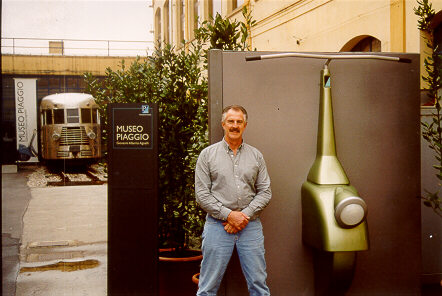 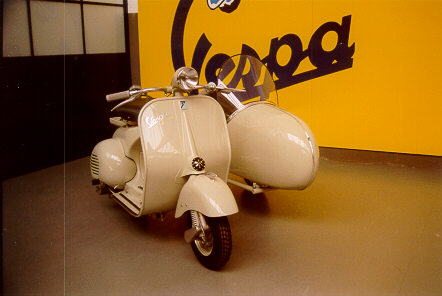 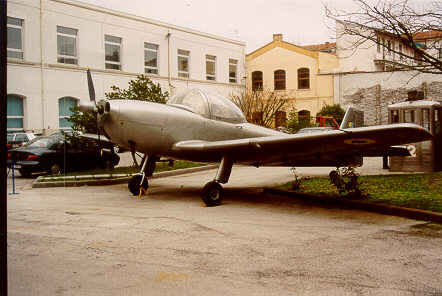 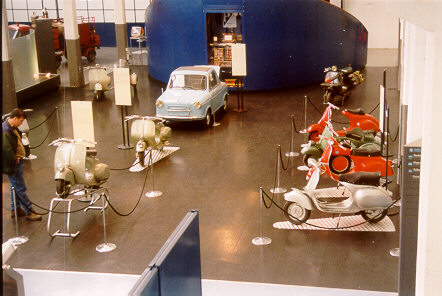 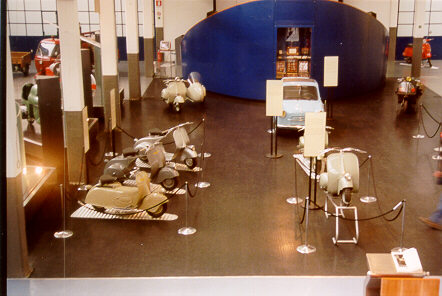 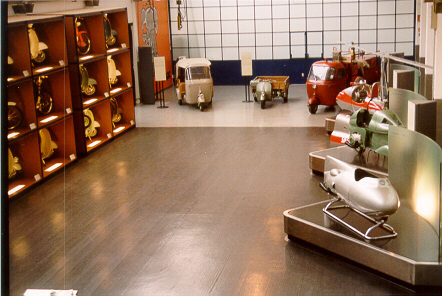 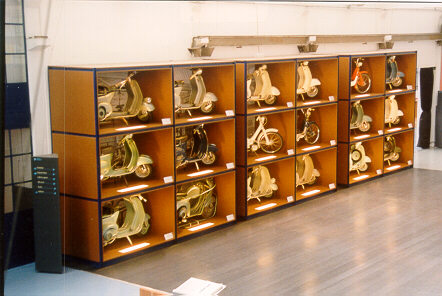 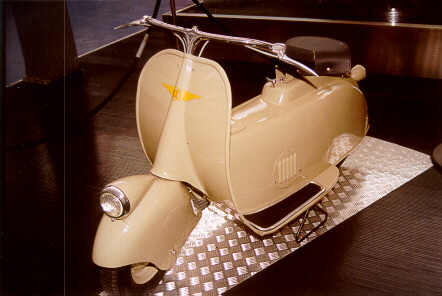 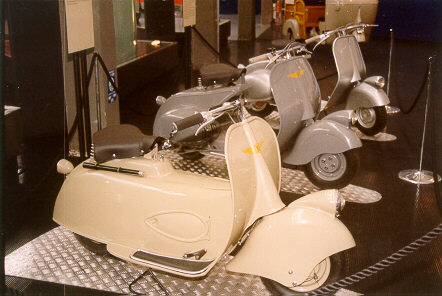 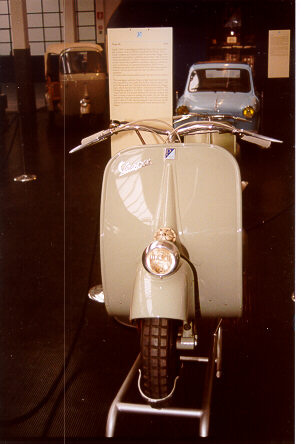 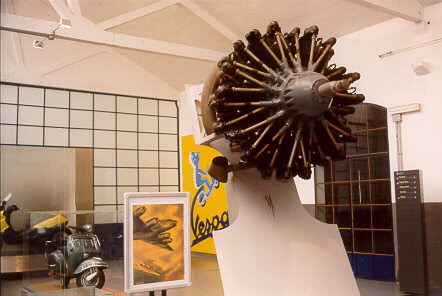 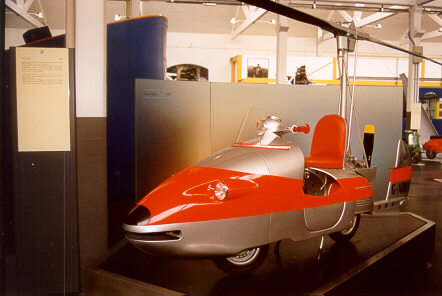 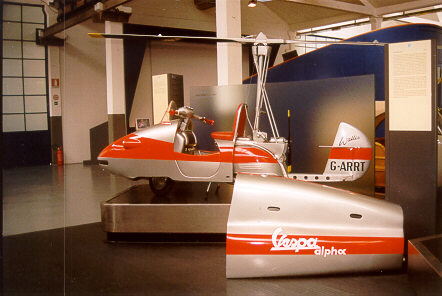 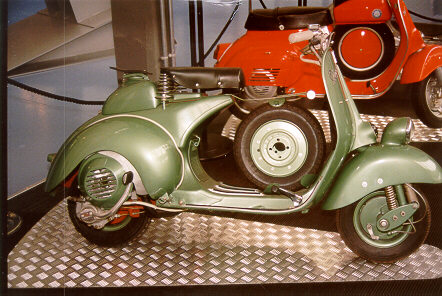 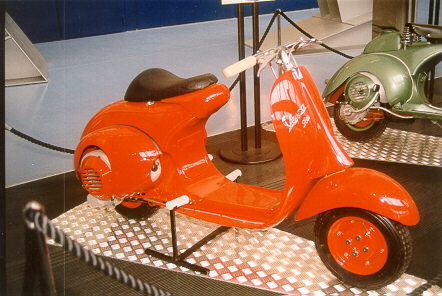 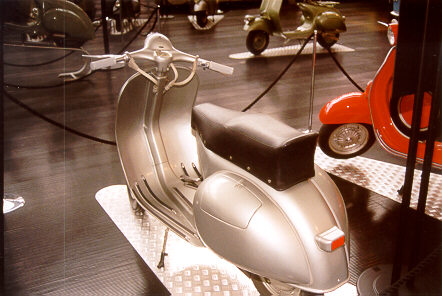 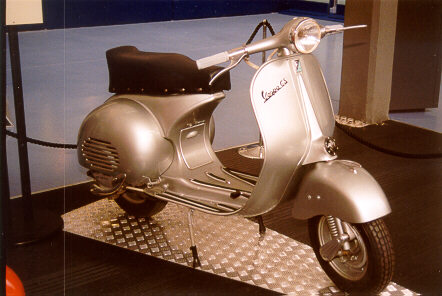 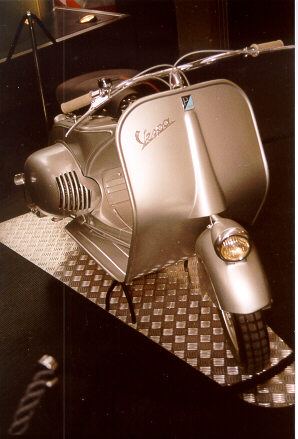 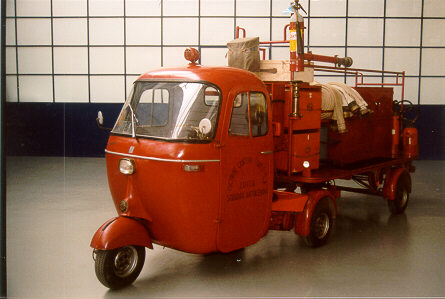 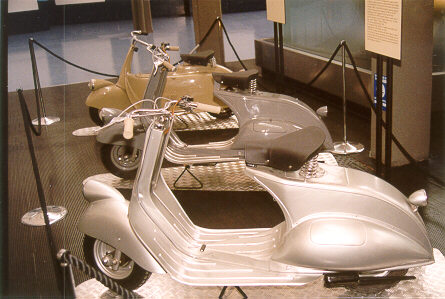 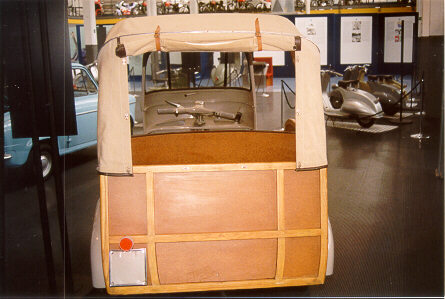 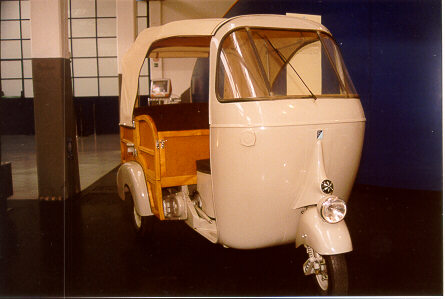 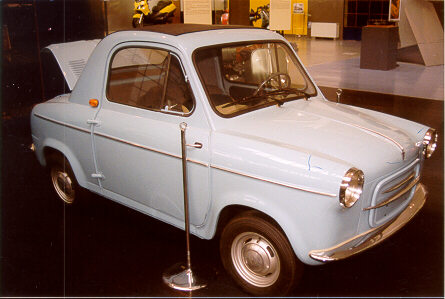 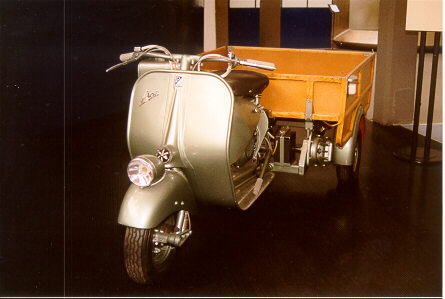
|
| ||||
| The Vespa Museum At the Piaggio Factory Pontedera, Italy By Alan Dollar | ||||
| Most scooter enthusiasts know the story of Piaggio developing the Vespa after World War II as a means of affordable transportation to aid in the re-construction of war torn Italy. The industrial history of the Piaggio Company actually began sixty years earlier in 1884 when they started making interiors, cabinets and fine woodwork for luxury liners and other sailing ships. Twenty years later the building of the Italian railroad was becoming a booming industry. The Piaggio Company diversified from woodworking to metal work. In 1908, they started producing a variety of railway cars and streetcars. Detailed, of course, with the same luxury interiors they had designed and produced for ships. In 1924, they branched out even further, adding an aeronautical division to their company. It was located in Pontedera. To aid the efforts of World War I they produced entire aircraft including engines. It was during that time that Enrico Piaggio and aeronautical engineer Corradino D’Ascanio, the two men who would later be responsible for developing the Vespa motor scooter, joined the company. Piaggio was in the forefront of airplane and engine development with many technical achievements to their credit. Did you know that D’Ascanio, that the man who designed the first Vespa, designed the first successful hovering helicopter in 1930? Such innovations ended during WW II when the Pontedera factory was demolished by allied bombing. Recovery from this devastation was the driving force that led to the invention of the Vespa! The first prototype MP5 (Moto Piaggio 5), developed in 1945, became known as the Paperino (Donald Duck). The design did not pass muster with Enrico Piaggio. He directed D”Ascanio to design a innovative vehicle for transportation based on aeronautical concepts. The resulting MP6 was labeled by Enrico as the Vespa because it looked to him like a wasp (vespa in Italian). The aerodynamics and monocoque (integrated) body were straight from airplane design. The front suspension was designed after the trailing link rear wheel of an airplane’s landing gear. The wheels were mounted on one side of the fork and engine to make it easier to change flat tires. The gears where shifted by twisting the grip where the clutch was located. All of these design innovations were firsts in the field of two-wheel transportation. That design led to a new direction for the Piaggio Company in 1946, and to the mass production Vespa scooters. It is a design and mechanical icon that has captured the imagination of people around the world for fifty-seven years! A number of enlightening books have been published in the last few years that include nice pictorial displays of the entire model line of Vespa. After reading all the books and studying all the photos, I, like many others, wanted to see the real thing, in Italy. So, Tony Garbarino and I cashed in our frequent flyer miles for a free flight to the homeland of Vespa, where we set off for a week to see nothing but scooter stuff! The plan was to see the Piaggio Vespa Museum, some private collections, parts suppliers and finish with the annual swap meet at Novergro. Tony, who knows Italy well, navigated us through his preplanned course like a seasoned rider through a Gymkhana. We did it all in a whirlwind, 8 days, 7 cities, and 6 hotels. We took one side trip from our scooter path in Pizza, to visit the only cultural site we would see while in Italy. The magnificent leaning tower had just reopened to the public after twelve years of construction to stabilize its tilt. It was a magnificent experience to stand on top of such a historic and beautiful structure. At the same time that I was in awe of my surroundings my mind kept saying, today we see Pontedera. I must be obsessed. At mid-day we found the sprawling Piaggio factory in Pontedera. The factory complex is larger than I imagined with rows of large concrete buildings, projecting the same appearance as pre war photos. The museum itself fills a small part of one building yet the display seems enormous. Rolf Soltou, former Piaggio representative to America, told me he was at the factory for a week of training later that month. He was shown almost all aspects of the grand facility. (Wouldn’t it be great to read an article about that experience?) The first scooters one sees upon arriving are the ones parked in front, ridden to work by the employees. On display outside the scooter museum are a commuter train and airplane, built by Piaggio before WWII. When we first arrived a chap in Piaggio overalls was outside preparing a newly acquired Vespa for the museum display. The original red Pentaro had been in service as a fire engine! Later during our visit, he drove the Pentaro fire truck into position in the display, complete with original axe, fire hose and siren. I spontaneously gave him and the Pentaro a rousing applause. He seemed pleased by that and motioned at us to follow him into the back room for more unique displays. The half-day we spent there flew by as if it were minutes. After leaving a lot of money at the museum store and receiving an armload of free goodies and posters, we were ready to embark on the next phase of our journey. As we walked to the entrance, a side door burst open and the jovial mechanic came out. He stuffed another handful of goodies into my bag and shook my hand. We had made another scooter friend, as so often happens when people who love Vespas meet! | ||||





